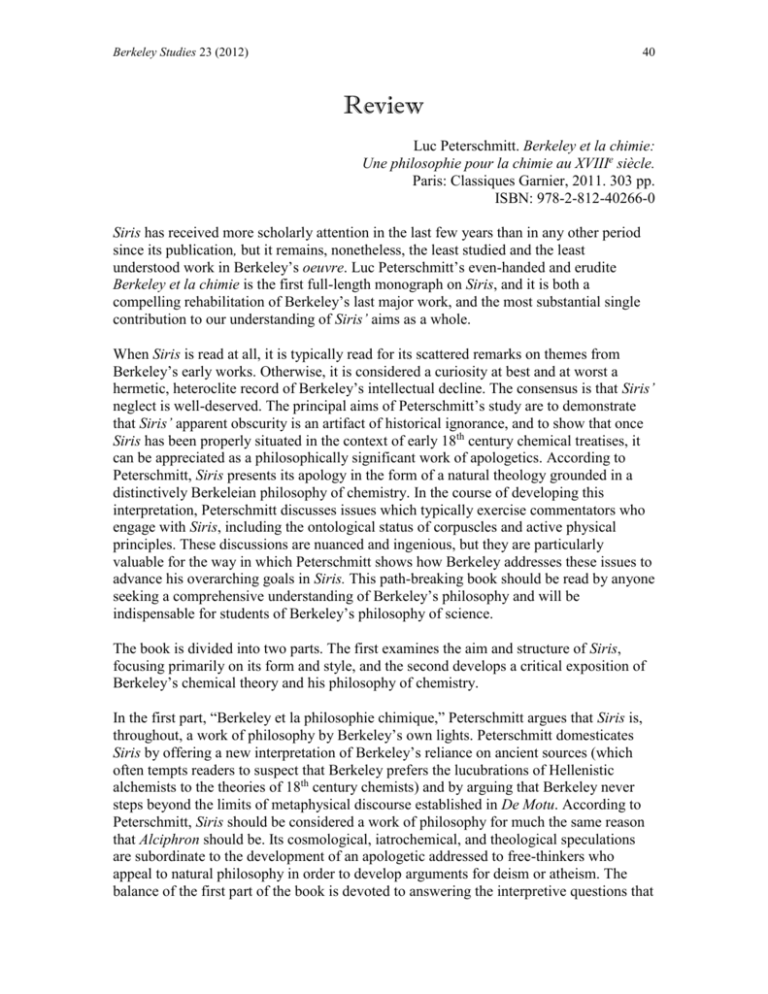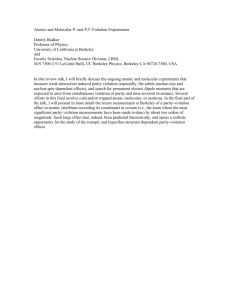BS_023_Holtzmann_Review
advertisement

Berkeley Studies 23 (2012) 40 Review Luc Peterschmitt. Berkeley et la chimie: Une philosophie pour la chimie au XVIIIe siècle. Paris: Classiques Garnier, 2011. 303 pp. ISBN: 978-2-812-40266-0 Siris has received more scholarly attention in the last few years than in any other period since its publication, but it remains, nonetheless, the least studied and the least understood work in Berkeley’s oeuvre. Luc Peterschmitt’s even-handed and erudite Berkeley et la chimie is the first full-length monograph on Siris, and it is both a compelling rehabilitation of Berkeley’s last major work, and the most substantial single contribution to our understanding of Siris’ aims as a whole. When Siris is read at all, it is typically read for its scattered remarks on themes from Berkeley’s early works. Otherwise, it is considered a curiosity at best and at worst a hermetic, heteroclite record of Berkeley’s intellectual decline. The consensus is that Siris’ neglect is well-deserved. The principal aims of Peterschmitt’s study are to demonstrate that Siris’ apparent obscurity is an artifact of historical ignorance, and to show that once Siris has been properly situated in the context of early 18th century chemical treatises, it can be appreciated as a philosophically significant work of apologetics. According to Peterschmitt, Siris presents its apology in the form of a natural theology grounded in a distinctively Berkeleian philosophy of chemistry. In the course of developing this interpretation, Peterschmitt discusses issues which typically exercise commentators who engage with Siris, including the ontological status of corpuscles and active physical principles. These discussions are nuanced and ingenious, but they are particularly valuable for the way in which Peterschmitt shows how Berkeley addresses these issues to advance his overarching goals in Siris. This path-breaking book should be read by anyone seeking a comprehensive understanding of Berkeley’s philosophy and will be indispensable for students of Berkeley’s philosophy of science. The book is divided into two parts. The first examines the aim and structure of Siris, focusing primarily on its form and style, and the second develops a critical exposition of Berkeley’s chemical theory and his philosophy of chemistry. In the first part, “Berkeley et la philosophie chimique,” Peterschmitt argues that Siris is, throughout, a work of philosophy by Berkeley’s own lights. Peterschmitt domesticates Siris by offering a new interpretation of Berkeley’s reliance on ancient sources (which often tempts readers to suspect that Berkeley prefers the lucubrations of Hellenistic alchemists to the theories of 18th century chemists) and by arguing that Berkeley never steps beyond the limits of metaphysical discourse established in De Motu. According to Peterschmitt, Siris should be considered a work of philosophy for much the same reason that Alciphron should be. Its cosmological, iatrochemical, and theological speculations are subordinate to the development of an apologetic addressed to free-thinkers who appeal to natural philosophy in order to develop arguments for deism or atheism. The balance of the first part of the book is devoted to answering the interpretive questions that Berkeley Studies 23 (2012) 41 this new reading of Siris raises. If Siris is a work of philosophy, then it becomes important to examine the relationship between it and Berkeley’s earlier philosophical works and to determine whether Berkeley’s philosophy evolved. Peterschmitt also explores Berkeley’s motivations for publishing a work devoted primarily to chemistry, attempting to explain among other things, Berkeley’s apparent lack of interest in chemistry prior to Siris. Taking a cue from Bertil Belfrage, Peterschmitt appeals to the principle of “Autonomous Fields of Discourse” from De Motu in order to specify the aim and nature of Siris. In De Motu, he points out, Berkeley argues that metaphysics, physics, and mechanics are autonomous disciplines distinguished by their methods and objects. Physicists aim to predict future events by means of observations and descriptions of past events, and mechanists develop general laws and theories to facilitate prediction. Only metaphysicians refer events to true causes, entities which can be considered active in a philosophically strict sense. These distinct fields of inquiry form a hierarchy. The aims of physics and mechanics are subservient to the aims of metaphysics in the sense that it is impossible to derive metaphysical principles from the observations on which physicists and mechanics rely, but necessary to ensure that the results of physics and mechanics are consistent with metaphysical principles which are established a priori. Thus, Peterschmitt proposes that Siris is not a work of natural philosophy but rather a work in which natural philosophy is submitted to metaphysical scrutiny in order to purify it of metaphysical claims that cannot be established from within natural philosophy. Though Berkeley alludes to the work of chemists in earlier works (e.g., the Theory of Vision), Peterschmitt suggests that Berkeley’s privileges chemistry in Siris for the first time because of developments both in chemistry and in Berkeley’s understanding of the field. It was Berkeley’s work with tar-water in the 1730s and 1740s which led him to examine contemporary treatises in which chemical theory was established as a legitimate branch of natural philosophy. It was only then that Berkeley saw that it would be possible to develop a philosophy for chemistry. Even though chemistry could be considered a separate and well-defined branch of science at the time Berkeley composed Siris, there had yet to emerge a figure to unify the field in the way that Newton unified mechanics in the 17th century. So in Siris, Berkeley not only develops a philosophy for chemistry, he also attempts to unify the field of chemistry—not as a chemist, but as a philosopher. Berkeley develops his analysis by subjecting the work of prominent 18th century chemists (especially the works of Homberg, Newton, and Boerhaave) to immaterialist critiques. This allows him to determine which of their claims could be true. But since chemistry was not yet a unified field, Berkeley was faced with a number of apparently competing claims. He adjudicates between them without performing novel experiments (as a chemist would) by showing that the disagreements are usually only apparent: when properly understood all leading chemists agree about most of the most fundamental chemical principles. Where true disagreements exist, Berkeley resolves them on purely philosophical grounds. Berkeley Studies 23 (2012) 42 As he develops this thesis, Peterschmitt discusses issues on which Berkeley scholars tend to focus, and in this way he emphasizes the significance of those issues to Berkeley’s project in Siris. For example, as an immaterialist Berkeley holds that the essence of spirit is to act and the essence of physical objects is to be perceived. Yet in Siris Berkeley seems to countenance the existence of unobserved objects, corpuscles, and an active physical principle, fire. To reconcile this latter position with the former, Peterschmitt shows that Berkeley develops an “occasionalist” interpretation of chemistry in two steps. First, he rejects all mechanistic chemical explanations in terms of the shape and movements of corpuscles in favor of explanations in terms of specific attractive powers— a view he attributes to Newton. He then explains attractions in terms of the movements of corpuscles. Since, for Berkeley, motion is an idea and hence “visibly inactive,” this interpretation allows him to conclude that the proper aim of chemistry is to display the rules or laws of nature, not to identify true causes. One can therefore speak of “active” principles but only as a natural philosopher, that is, not in metaphysical strictness. This view may seem problematic, since we apparently have no ideas of the motions of corpuscles, but Peterschmitt argues that Berkeley’s commitment to the existence of unobserved physical objects is both consistent and well-motivated. In general, unobserved phenomena pose no special challenges to immaterialism since they may be analyzed conditionally. The heliocentric hypothesis, for instance, becomes a set of propositions concerning what one would see if, for example, one were transported beyond the sphere of the earth. Claims about corpuscles can be construed in the same way, provided there are good reasons to posit the existence of corpuscles. Prior to his exposure to the works of 18th chemists like Boerhaave and Homberg, Berkeley did not think that there were such reasons, so he neither endorsed nor rejected the existence of corpuscles in his early works. The case is different, though, in the context of Berkeley’s treatment of chemistry in Siris, since the very possibility of explanation in 18th century chemistry not only presupposes the existence of corpuscles but also provides observational evidence for their existence. In particular, Berkeley believed that Homberg’s experiments on the calcination of metals showed that corpuscles have weight (an observable property), and that this is evidence that corpuscles should be considered real entities and not mere theoretical posits, even by an immaterialist. Peterschmitt concludes that if Berkeley’s philosophy evolved over the course of his career, the turning point came much earlier than Siris. For on his interpretation, Berkeley, far from departing from immaterialism, relies crucially on immaterialist principles in developing his philosophy of chemistry, and on the metaphilosophy and philosophy of science of De Motu. Berkeley’s improved understanding of chemistry allowed him to demonstrate the views he had always held about the hierarchy of scientific disciplines by showing how the aims of chemistry promote the aims of philosophy and religion. In the second part of the book, “La théorie chimique selon Berkeley: chimie et apologétique,” Peterschmitt characterizes Berkeley’s philosophy of chemistry and establishes its role in Siris’ apologetic. This section is perhaps the more valuable of the two since it is here that Peterschmitt illuminates the text considerably by recovering Siris’ scientific context, a context unfamiliar to most contemporary readers. Berkeley Studies 23 (2012) 43 He begins by explaining and evaluating Berkeley’s efforts to unify the field of chemistry, tracking Berkeley’s discussions of acids, salts, air, and fire step by step. Since Berkeley seems to effect this unification almost completely and for the first time, the central aims of the section are to determine whether Berkeley’s readings of 18th century chemical treatises are accurate and whether his proposed synthesis succeeds. For example: Berkeley argues that all prominent 18th century chemists agree that there is only one physical principle (viz., fire) that can be said to be “active” in the natural philosophical understanding of that term. Peterschmitt critically evaluates Berkeley’s claims that Newton’s aether and Homberg’s sulphur (elements which are said to be both active and fundamental) are identical to the principle of fire. While he finds that Berkeley’s readings of Newton and Homberg appear to be tortured, he grants that Berkeley was not alone in suggesting it, noting that Stephen Hales (a “respectable Newtonian”) made a similar suggestion at about the same time Berkeley composed Siris. This is characteristic of Peterschmitt’s findings. He suggests that Berkeley often misinterprets the chemical treatises at his disposal—as in his conflation of varieties of sulphur with the principle Sulphur in his reading of Homberg—and yet he remains sympathetic to Berkeley’s attempt to forge a unified chemical theory. The goal is worthy, and though Peterschmitt judges it to be impossible to meet, it is not for that reason quixotic because Berkeley had legitimate hope of success. Siris is philosophically interesting, then, because Berkeley’s attempt to unify chemistry is serious and in some respects successful, and because Berkeley’s attempt to provide his chemical theory with metaphysical underpinnings is compelling and distinctive. But Siris is also significant as a work of Christian apologetics. Berkeley addresses free-thinkers who believe that 18th century mechanics implies atheism by first insisting that chemistry, not mechanics, is the more fundamental branch of natural philosophy; and then he shows that this means that the interactions between physical objects, in the final analysis, must be explained in terms of specific attractive virtues that do not themselves admit of mechanical explanation. More importantly, Berkeley argues that the chemical analysis of particular physical objects and the study of chemistry in general lead to arguments for the existence of a providential God. Since tar-water is plentiful, cheap, and easy to prepare, this means that if it is a panacea, as Berkeley believes, then its creator must be beneficent and providential. Fire is the vehicle by means of which God acts in the world, so no effect is accomplished without it. It is both a pervasive and extremely powerful, volatile element, yet the world is pleasantly heated and not engulfed in flame. Thus, the study of fire, the active principle of tar-water, also puts us in mind of God’s care for us and his great power. Finally, the analogy that Berkeley draws between natural and artificial chemistry (roughly speaking between what human chemists can accomplish in their laboratories and what God can accomplish through chemistry in the cosmos) helps us to appreciate how God’s chemistry is vastly superior to our own, inspiring a proper awe in the face of creation. Peterschmitt concludes that Siris may be profitably read together with De Motu—since it applies many of the philosophical claims about natural philosophy from De Motu to chemistry—and (as Laurent Jaffro has argued) with Alciphron—since its aims are Berkeley Studies 23 (2012) 44 primarily apologetic and pedagogical. The reason that most readers find Siris to be too strange to read seriously is that they do not properly appreciate the context in which it was composed. Peterschmitt shows that against this background it reveals itself to be, among other things, a sustained, coherent, and innovative contribution to the philosophy of 18th century science. Berkeley et la chimie will henceforth serve as a touchstone for Siris scholarship and should become a key source for all general treatments of Berkeley’s thought, since, with only a very few exceptions, such works give Siris short shrift. I have, however, a few reservations about the work, reservations which would tend, if well founded, more to highlight the need for further work on Siris than to undermine any of the results of Peterschmitt’s research. Early on, Peterschmitt admits that he restricts himself to a discussion of Berkeley’s philosophy of science. This would seem to indicate that he intends to bracket at least some questions concerning Siris’ broader philosophical significance. The circumscribed conclusions of the book thus seem well-supported: Siris is worth reading because it contributes to our understanding of 18th century philosophy of science, the evolution of the philosophy of science in general, and our understanding of Berkeley’s philosophical work as a whole. However, although Peterschmitt rarely trespasses the boundaries he sets for himself, when he does, he sometimes closes off avenues of research. For example, in noting how Berkeley appeals to ancient sources throughout the Siris and not only in the sections on chemistry, Peterschmitt draws attention to how Berkeley does not turn away from rigorous philosophical analysis in order to luxuriate in abstruse metaphysical and alchemical speculations. Furthermore, in his effort to rehabilitate Siris, Peterschmitt’s account obviously is intended to apply to the text as a whole—for at least three reasons. First, Berkeley had rhetorical reasons for writing the book, for his appeals seem to have the objective of cloaking contemporary chemists in a mantle of respectability. Second, Berkeley had theoretical reasons, for he sought additional confirmation for his view that fire plays a central cosmological role. Third, Berkeley appealed to the ancients as part of his apology, because he wanted to show that free-thinkers can’t appeal to the ancients in their arguments for atheism. The important point is that these appeals play only a secondary role in Berkeley’s argument. This must be the case, according to Peterschmitt, since otherwise a central argument in his apologetic will be circular and for two reasons. First, it will seem that Berkeley appeals to the ancients to support the theories of the moderns and vice versa; and, second, it will seem that Berkeley endorses only those ancient views which happen to suit his apology. Peterschmitt seems right to identify rhetorical and theoretical reasons for Berkeley’s use of the ancients, though it should be added that if he relies at all on their authority, he also takes great pains to establish it. Berkeley was convinced that many of the ancient works to which he appeals in Siris are rejected out of hand by his contemporaries, and he upbraids them for this. It strikes me, however, that here Peterschmitt’s contextualization is insufficient insofar as he privileges contemporary views of the aims of philosophy in judging whether Berkeley’s use of the ancients is philosophical. In Siris Berkeley aligns himself with an outmoded and deeply syncretistic natural philosophical tradition to which Newton, as a Berkeley Studies 23 (2012) 45 chemist, also belonged. Scientists like Bacon, chemists like Newton and philosophers of chemistry like Berkeley believed in the existence of a prisca sapientia (or as Berkeley calls it in Siris, theoparadotos philosophia), and they understood the scientific project as one of recovery not discovery (since this “pristine knowledge” was mostly lost). When Berkeley discovers ancient precedents to the cosmology of fire developed by 18th century chemists, he sees himself as confirming the chemists’ results, and I think that there is no need to worry that this procedure is circular. Just as Berkeley appeals to immaterialist principles of intelligibility to critique 18th century chemists—rejecting, for instance, any suggestion that chemical principles are truly active—so he also relies on those principles to reveal how ancient philosophers separate prejudices from the glimmerings of the divine tradition. Just as Miles Burnyeat criticizes Berkeley’s claim that Plato and Aristotle were really immaterialists, so also Berkeley’s readings of the ancient philosophers are often as tortured as his readings of the modern chemists. But Peterschmitt minimizes this because in his account, Berkeley sees himself as criticizing both ancients and moderns according to the same standards; and because he is committed to the existence of a divine tradition, agreement with the ancients would be significant evidence of the truth of the conclusions of 18th century chemists. This criticism is minor, but it is worth registering nonetheless since, at least in this regard, Peterschmitt’s project of rehabilitation and domestication tends to obscure rather than reveal Siris’ intellectual context. Siris seems strange not only because it is developed against a scientific context that few understand, but because it is animated by philosophical concerns and commitments that few contemporary readers share. Matthew Holtzman Washington College matthewholtzmann@gmail.com







